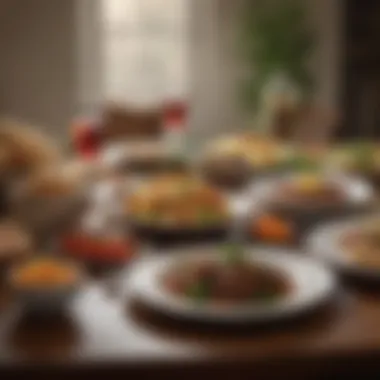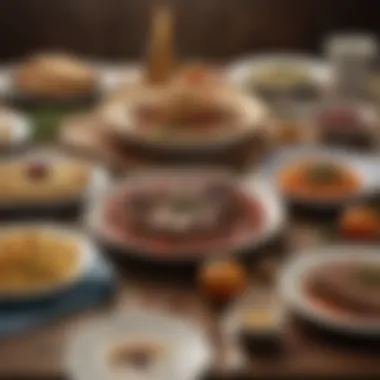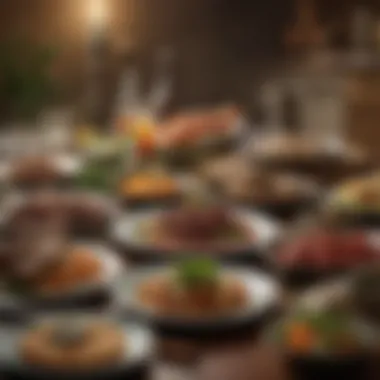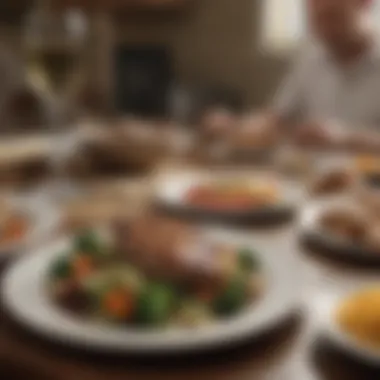Understanding Passover: The Meal and Its Significance


Intro
Passover, known as Pesach in Hebrew, is a time of deep reflection, remembrance, and communal gathering in Jewish culture. The central component of this celebration is the Seder meal.
During the Seder, families and friends come together to commemorate the Exodus from Egypt. This meal is not just a time to eat. It unfolds as a rich tapestry of rituals and symbols that date back thousands of years. Each element on the Seder plate holds profound meaning. Understanding Passover involves delving into the historical roots of these customs and examining their relevance today.
As we explore this topic, we will discuss the structure of the Seder meal, the significance of each dish served, and the way these traditions persist in modern Jewish life.
Historical Context of Passover
Understanding the historical context of Passover enriches one's appreciation of its meaning and observances. The roots of Passover stretch back to ancient times, intertwined with significant events in Jewish history. This context is pivotal for grasping both the symbolic and practical aspects of the Passover meal.
Origins in Ancient Egypt
The origins of Passover are closely related to the Israelites' time in ancient Egypt. According to historical and religious texts, the Israelites were enslaved for several centuries. This oppression created a deep yearning for freedom. Passover commemorates the pivotal moment when God delivered the Israelites from slavery through a series of divine interventions. The dramatic events leading up to this liberation include the plagues inflicted upon Egypt, culminating in the final plague that led to their emancipation.
The name "Passover" itself derives from the Hebrew word "Pesach," which signifies the act of passing over. In the biblical narrative, the angel of death passed over the Israelite homes marked with lamb’s blood, sparing them while striking down the firstborn of the Egyptians. This event was not just a historical moment but a formative experience, shaping the collective identity of the Jewish people.
The Exodus Narrative
The Exodus narrative is central to the Jewish faith and culture. It details the journey of the Israelites as they fled Egypt, led by Moses, who confronted Pharaoh regarding their release. The story illustrates themes of struggle, resilience, and divine support. By narrating this journey every year during Passover, Jews reconnect with their history and reaffirm their collective memory.
The importance of this narrative extends beyond its historical aspects. It serves as a powerful reminder of the value of freedom and justice, resonating with many struggles around the world today. The story inspires reflection on the human experience of oppression and the universal quest for liberation.
The Significance of the Passover Meal
The Passover meal, or Seder, is a culmination of deep-rooted traditions and meaningful rituals. It encapsulates both historical narratives and evolving interpretations. This meal is much more than just food; it is a profound expression of faith, memory, and cultural identity. Understanding its significance helps to appreciate not only the meal itself but also what it represents in a broader context.
Spiritual and Religious Dimensions
At the core of the Passover meal is a spiritual journey. The Seder is structured around themes of liberation and redemption. Each component of the meal serves a distinct purpose, helping participants reflect on the Jewish experience of slavery and freedom.
- The act of eating matzah symbolizes the hurried escape from Egypt, as there was no time to let the bread rise.
- Maror, the bitter herbs, evokes the harshness of slavery that the Jewish people endured.
- Charoset, a sweet mixture, represents the hope and continuity of life amidst suffering.
Through these elements, the meal fosters a connection to divine observance. It invites participants to engage in prayers and songs that frame the historical context of the Exodus narrative. The rituals serve to reinforce the collective memory, making it a spiritual exercise as much as a social gathering.
"The Seder is a time for questioning and understanding, where the past informs the present and shapes the future."
Cultural Identity and Heritage
The Passover meal is also a vital marker of cultural identity. It allows Jewish communities to celebrate their heritage while passing down traditions to new generations. The Seder is often described as an intergenerational experience, where stories, songs, and customs are shared across ages.


The various aspects of the meal, from the Haggadah readings to the rituals like the Four Questions, highlight the importance of education and remembrance in Jewish culture. It ensures that the values of liberation, justice, and community remain alive in each generation.
- The participation of children during the Seder is crucial. It emphasizes the significance of education in shaping cultural continuity.
- Additionally, items on the Seder plate commonly vary regionally, reflecting local customs and practices, which enrich the Passover experience.
Through the Seder, individuals affirm their identity and engage with their history in a dynamic manner. The meal becomes a touchstone for unity and a reinforcement of shared beliefs.
In summary, the significance of the Passover meal transcends its physical components. It embodies spiritual themes and cultural heritage, fostering an environment of reflection and community engagement for all who partake.
Components of the Passover Seder
The components of the Passover Seder are essential elements that encapsulate the entire significance of the holiday. Each item on the Seder plate carries deep meanings and serves a unique purpose within the rituals of the meal. Understanding these components allows one to appreciate the rich heritage behind each symbol, as well as the narrative of freedom and faith that Passover embodies. The items included in the Seder play roles that go beyond the physical presence on the table; they participate in storytelling, remembrance, and creating a sense of community during the Seder night.
Matzah: The Unleavened Bread
Matzah, or unleavened bread, is a central element of the Passover meal. It symbolizes the haste with which the Israelites left Egypt, not having time for their bread to rise. Matzah serves both practical and educational purposes at the Seder. It is a tangible reminder of the hardships faced by the Jewish ancestors and the liberation they eventually achieved. Eating matzah during the Seder is a mitzvah (commandment), and it is traditionally eaten three times throughout the evening, reinforcing its importance in the celebration.
Maror: The Bitter Herbs
Maror, often prepared from horseradish or romaine lettuce, represents the bitterness of slavery endured by the Jews in Egypt. The act of consuming maror evokes poignant emotions reminding participants of the pain and suffering that marked their forebears' journey. This experience ties back into the overarching theme of the Seder: to remember the trials faced and emerge with gratitude for freedom. It is customary for participants to dip the maror into charoset to soften its taste, symbolizing the mixture of hardship and hope.
Charoset: The Sweet Mixture
Charoset is a sweet mixture that typically consists of chopped apples, nuts, wine, and cinnamon. This dish represents the mortar used by the Jewish people to make bricks during their periods of forced labor. However, its sweet flavor contrasts sharply with the bitter maror, embodying the notion of hope and resilience amidst hardship. The blend of flavors not only enriches the Seder plate but also symbolizes the importance of memory, emphasizing that even in tough times, sweetness can be found.
Karpas: The Green Vegetable
Karpas, often parsley or celery, serves as a green vegetable for dipping in salt water during the Seder. The green symbolizes spring, rebirth, and renewal - concepts deeply interwoven with the themes of Passover. Dipping the karpas into salt water brings forth reflections on the tears shed during slavery. This act resonates with the participants, eliciting a discussion about the unity of joy and sorrow in the narrative of the Jewish people.
Z'roa: The Shank Bone
The z'roa refers to the roasted shank bone of a lamb and serves as a poignant representation of the Paschal lamb that was sacrificed during the Exodus. This element signifies the ancient rituals tied to the Jewish identity. The presence of the z'roa on the plate evokes discussions about the Temple in Jerusalem and the importance of sacrifice and redemption in Jewish history. It stands as a powerful reminder of faith and continuity.
Beitzah: The Roasted Egg
Beitzah, a roasted egg, represents mourning. Its inclusion on the Seder plate symbolizes the destruction of the Temple in Jerusalem and serves as a reminder of loss within the broader narrative of redemption. The egg also embodies the cycle of life and rebirth. It is customary to eat the beitzah, further reinforcing the connections between memory, loss, and the continuity of the Jewish people. Each of these components weaves together a complex tapestry that enriches the Seder experience, offering insight into resilience, faith, and identity.
Rituals and Traditions of the Seder
The rituals and traditions during the Passover Seder are essential to the overall experience of the holiday. They serve to connect participants to history, foster community, and instill a sense of identity. Each element of the Seder holds deep meaning, providing a rich tapestry of practices that have been passed down through generations. By participating in these rituals, individuals not only remember their past but also affirm their religious and cultural beliefs.
The Four Questions


The Four Questions, or Ma Nishtana, form a fundamental part of the Seder. Traditionally asked by the youngest child present, these inquiries highlight the differences between Passover and ordinary nights. They question why matzah is eaten, why bitter herbs are consumed, and why reclining during the meal occurs. This practice serves as a pedagogical tool, encouraging curiosity and engagement in the Seder. It is believed that by asking questions, younger generations learn about their heritage and the reasons behind the Seder's practices. The Four Questions embody both transmission of knowledge and a celebration of freedom, as they signal the start of the narrative that recounts the Exodus from Egypt.
The Passover Haggadah
The Haggadah is a text recited during the Seder that outlines the order of the meal and the rituals performed. It includes the story of the Exodus, prayers, and songs that are integral to the evening's festivities. This guide is not merely a manual; it plays a crucial role in spiritual reflection and community bonding. Various editions of the Haggadah exist, each reflecting diverse cultural interpretations and traditions. The choice of Haggadah can express individual beliefs and values, making it a personal artifact as much as a communal one. The reading of the Haggadah is a centerpiece of the Seder, inviting discussions about freedom, oppression, and identity that remain relevant today.
The Role of Wine
Wine holds a prominent place in the Passover Seder, symbolizing joy and freedom. Four cups are traditionally consumed throughout the meal, each representing a different aspect of redemption. The act of drinking wine during the Seder enhances the festive atmosphere, encouraging participants to reflect on the significance of freedom and celebration. Additionally, wine consumption underscores the importance of ritual in Jewish life, reinforcing communal bonds and shared experiences. The quality and type of wine can vary, but it often reflects personal tastes and regional practices.
"Wine, in its role at the Seder, transcends mere beverage; it is a conduit for joy and reflection."
Wine rituals invite participants to imbibe not only the drink but also the deeper meanings associated with Passover, making this element an exhilarating part of the Seder.
Through the Four Questions, the Haggadah, and the shared consumption of wine, the Seder encapsulates a blend of history, culture, and spirituality. Each ritual prompts reflection on Jewish identity and the shared narrative of liberation.
Contemporary Interpretation of Passover
The contemporary interpretation of Passover reflects how age-old traditions adapt to modern contexts. This yearly celebration has moved beyond its historical and religious boundaries. Today, its meanings encompass themes of freedom, unity, and cultural continuity, appealing to a broader audience, including those less familiar with Jewish customs.
In recent years, many families have incorporated new symbols and ideas into their Seder plate. These modern additions represent current social justice issues, engaging participants in meaningful discussions about contemporary struggles. For example, adding a piece of orange symbolizes the inclusion of women and the LGBTQ+ community in Jewish life.
Additionally, the act of acknowledging global oppression during the Seder emphasizes universal themes of liberation. This connection highlights the ongoing fight for human rights, making the meal relevant beyond a religious observance. It shows the capacity of Passover to inspire action and awareness in today’s world.
Modern Additions to the Seder Plate
As traditions evolve, one of the most visible changes in Seder practices is the inclusion of modern additions to the Seder plate. Some new items that families may include are:
- Orange: Symbolizes inclusion and equality, particularly for women and LGBTQ+ individuals.
- Romaine Lettuce: Acknowledging the growing awareness of agricultural practices and sustainability issues.
- Avocados: Represents green living and health consciousness.
These updates serve to engage younger generations, allowing for dialogue on significant issues while maintaining the essence of the Passover meal.
Passover in a Global Context
With the spread of Jewish communities throughout the world, Passover has adapted and taken on different forms globally. Each community offers unique interpretations influenced by local customs and historical experiences.
For instance, in America, the celebration emphasizes family gatherings and communal meals, focused on storytelling and teaching the younger generations about their heritage. Meanwhile, in countries like Argentina, Passover celebrations incorporate local foods, blending culinary traditions with religious flavors.
These variations foster a sense of belonging and identity within diverse populations, reinforcing the meal's cultural importance. Understanding how Passover manifests worldwide enhances its significance, linking Jewish history with global narratives of freedom and hope.
Moreover, in multicultural environments, people of different backgrounds may participate in Passover celebrations, expanding the holiday's reach. This engagement can promote interfaith dialogue and appreciation, revealing the common threads of human experience shared across cultures.


The Experience of the Passover Meal
The Passover meal is not merely an act of eating; it is a profound experience that melds history, spirituality, and family. The Seder, the ceremonial dinner associated with Passover, serves as a conduit for remembering the Exodus from Egypt. Each element of the meal is carefully orchestrated to encourage participants to engage with their heritage and the themes of liberation and oppression. This experience is vital, as it embodies the collective memories and aspirations of the Jewish people.
The Seder invites participants into a deeply personal journey. The gathering of family and friends is central to the evening, creating a space where narratives are shared and tradition reverberates. As people come together, they not only celebrate the present but also connect with those who came before them. This aspect of community is an irreplaceable component of the Passover meal that enhances its significance.
Gathering for the Seder
Gathering for the Seder is more than just a physical assembly. It frames the evening's context, rich with anticipation and reverence. Families often prepare in advance, with discussions about the meanings of the Seder rituals. The table setting becomes an important symbol, showcasing preparation that reflects respect for the holiday and its customs.
During the Seder, participants engage with several rituals. These include reading from the Haggadah, reciting the Four Questions, and tasting specific foods on the Seder plate. Each act reinforces the themes of memory and identity. Traditionally, the Seder unfolds with songs, prayers, and specific blessings over the wine and matzah. This structure provides continuity in Jewish tradition, passing down knowledge from one generation to the next.
Moreover, the Seder is a platform for intergenerational dialogue. Young participants often ask questions, fulfilling the commandment to educate them about their history. This dynamic encourages a deeper understanding of Passover's significance and the continued relevance of its themes, even in contemporary society.
Reflections on Freedom and Oppression
As participants engage in the Passover meal, themes of freedom and oppression surface profoundly through the readings and rituals. The Exodus story is a narrative of liberation from slavery, a fundamental element of Jewish identity. These reflections invite critical thinking about the nature of freedom, justice, and the moral responsibilities of individuals in today’s world.
The contrast between the oppressive conditions faced in ancient Egypt and the freedom celebrated in the present day serves as a poignant reminder of ongoing struggles against injustice globally. This can lead participants to contemplate their own responsibilities toward marginalized communities and examine the societal structures that perpetuate inequality.
Through shared stories of resilience and adversity, the Seder instills a sense of urgency and commitment towards social justice.
"In every generation, each person must see themselves as if they had come out from Egypt."
By engaging with the themes of the Passover narrative, individuals are called to reflect on their personal and collective roles in promoting justice, equality, and freedom today.
The experience of the Passover meal, therefore, transcends the eating of food. It encapsulates a significant rite of passage that ties individuals and families to their heritage while facing contemporary moral dilemmas. Each gathering reaffirms commitments to values deeply rooted in historical struggles, ensuring they remain relevant in our current society.
Passover and Its Lessons for Today
The remembrance of Passover serves as a poignant reminder of the struggles and triumphs in human history. The lessons learned during this time are valuable to understanding our contemporary issues. At its core, Passover is not just a historical account but a story that resonates with many in today's world. In this section, we will explore how the narratives of Passover can be related to modern societal challenges and the importance of remembering our histories.
Relating Historical Narratives to Modern Issues
The story of the Exodus, which forms the foundation of the Passover celebration, deals fundamentally with themes of freedom and oppression. This narrative is relevant today as many around the globe continue to face injustice and struggle for basic rights. When we reflect on the journey of the Israelites from slavery to freedom, we can draw parallels to contemporary movements focused on civil rights, social justice, and the fight against discrimination.
By connecting these historical experiences to current events, individuals and communities can find inspiration and strength. The message of resilience and hope during Passover encourages those facing adversity to press forward. It becomes essential to advocate for equality and to recognize the ongoing struggles for freedom globally. Acknowledging these connections helps foster a deeper understanding of current social issues while paying homage to the past.
The Importance of Remembrance
Remembrance during Passover is more than a simple retelling of events. It serves to educate and instill values in younger generations. The act of recalling historical narratives promotes awareness and understanding of the sacrifices made by those who came before us.
- Lessons from the past: It is crucial to remember that the hardships endured by the ancestors are not merely for reflection but to teach us resilience and courage.
- A call to action: This remembrance also acts as a prompt to take action against injustices that persist in our society.
The rituals associated with Passover invite participants to consider their roles in combating oppression and fostering change. Engaging with these lessons can create thoughtful dialogues about responsibility and moral action in today’s world. Overall, Passover encapsulates a rich array of lessons that, when thoughtfully contemplated, can guide our actions towards justice and compassion in our communities.
"To remember is to face the past and acknowledge its lessons. In understanding where we come from, we gain insight into where we must go."
As we conclude this discussion, it is apparent that the teachings of Passover extend far beyond the confines of tradition and ritual. They urge us to remain vigilant and to lend our voices to those still seeking freedom and justice.



